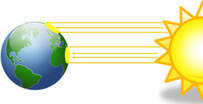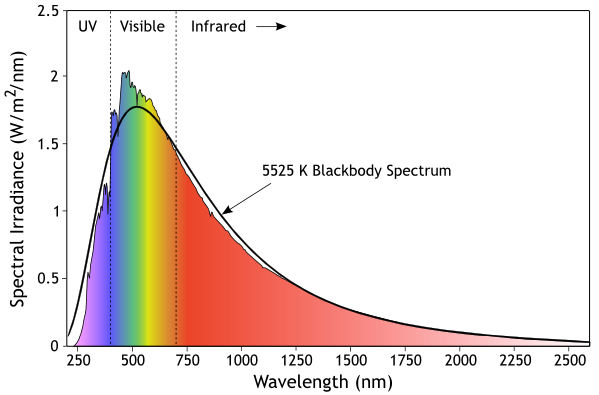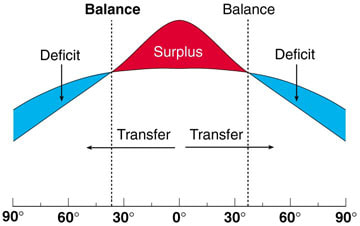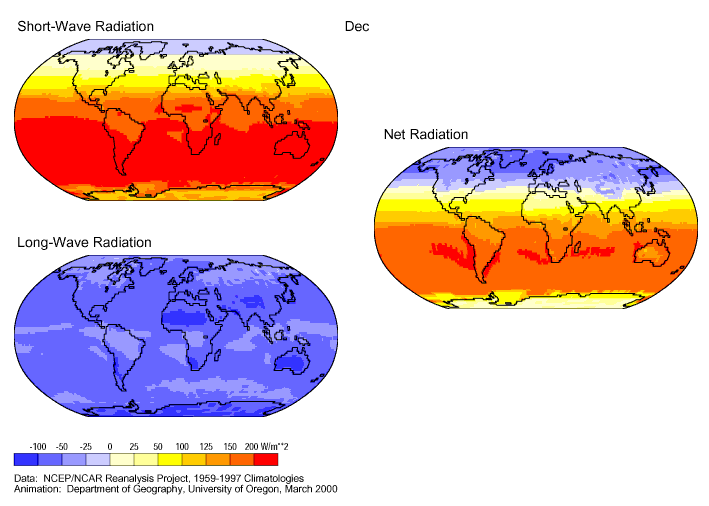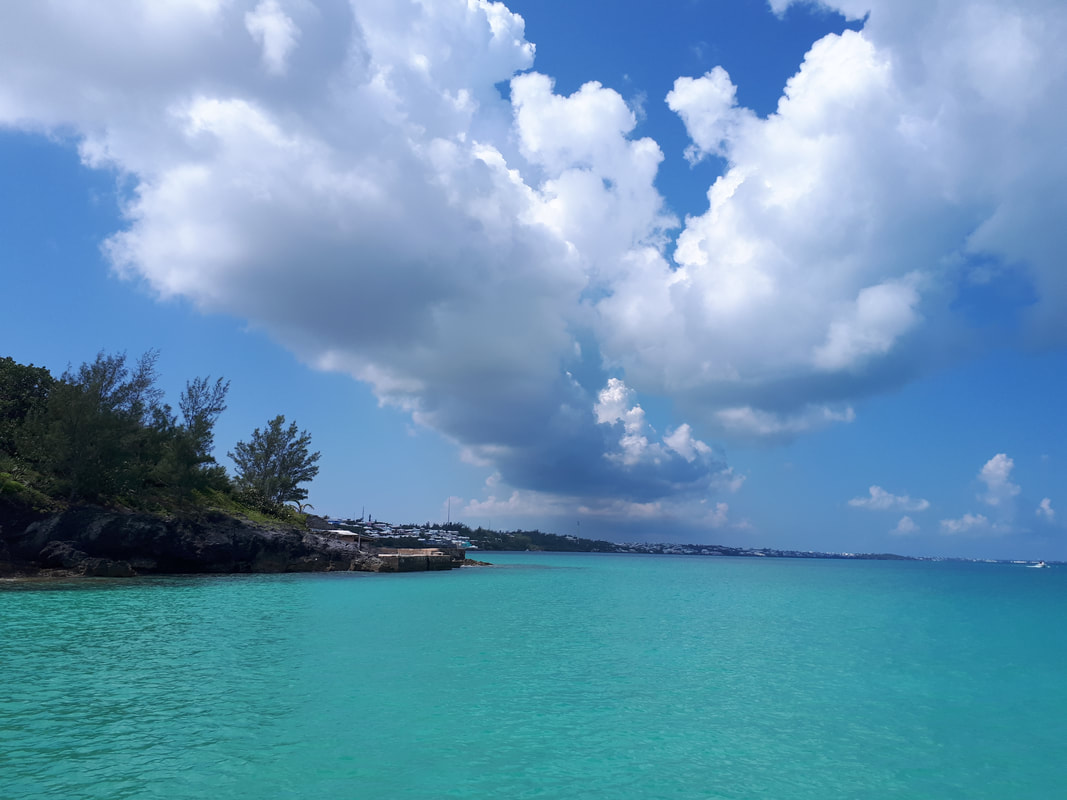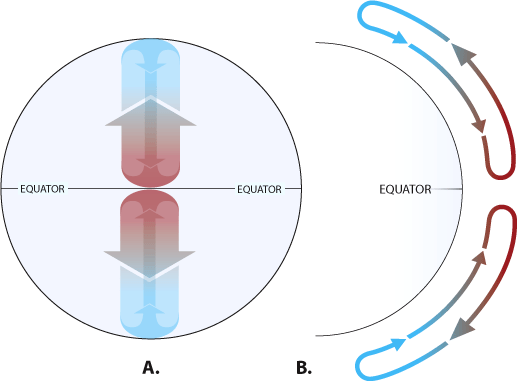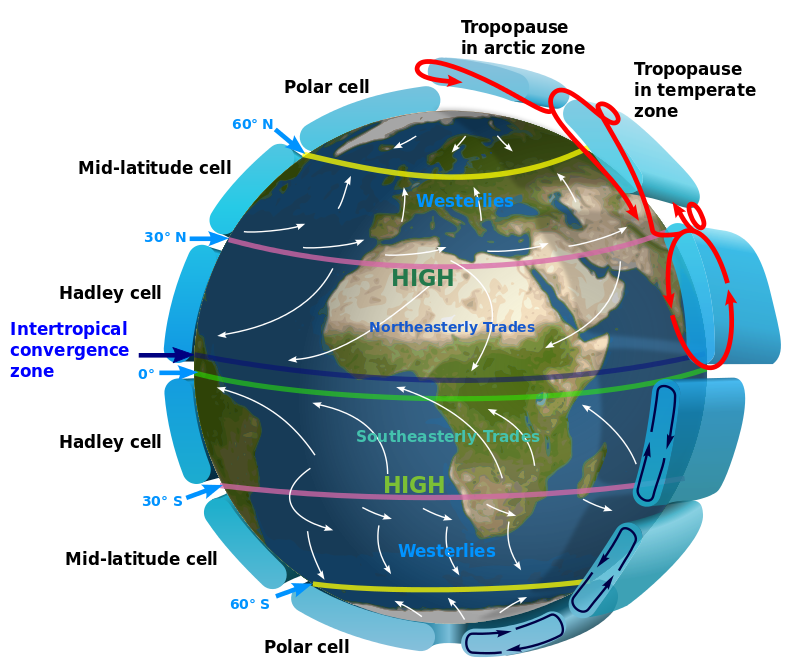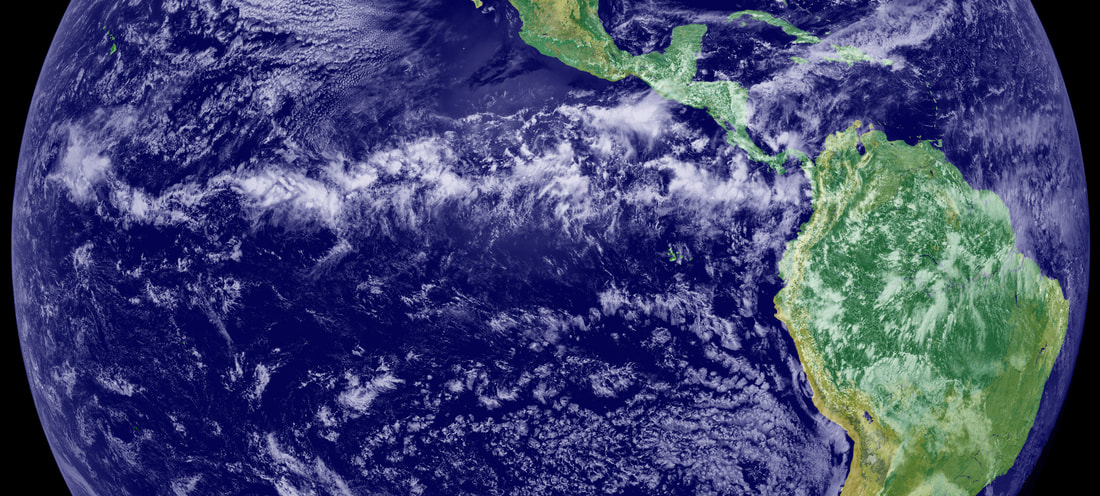3.1 - The Global Heating, Seasons and Convection
Objectives:
- To know that the Sun warms the Earth and does so unevenly.
- To understand that the uneven heating of the Earth leads to heat transfer by convection of the atmosphere and oceans.
- To understand that this heat transfer moves heat from the tropics to the poles.
The movements of the ocean and atmosphere is ultimately caused by the uneven heating of the Earth and the subsequent transfer of heat from warm areas to cold. There are four factors that cause this uneven heating:
The Earth is a Sphere
Heat always travels from HOT objects to COLD objects. The surface temperature of the Sun is roughly \(6000^{\circ}\text{C}\) and it radiates heat as a mixture of infrared, visible and ultraviolet radiation. Energy radiating from the far hotter Sun strikes the cooler Earth in a uniform pattern, however due to the curvature of the surface a given amount of this energy is spread over a larger area, so has less heating effect. Another way of looking at it is as the Sun appears lower on the horizon at the poles, the Sun has less direct influence. This means that the tropics receive more concentrated heating than the polar regions.
- The Earth is a sphere.
- The Earth spins on an axis.
- The Earth's axis is tilted with respect to the orbital plane.
- Land and oceans have different heat capacities.
The Earth is a Sphere
Heat always travels from HOT objects to COLD objects. The surface temperature of the Sun is roughly \(6000^{\circ}\text{C}\) and it radiates heat as a mixture of infrared, visible and ultraviolet radiation. Energy radiating from the far hotter Sun strikes the cooler Earth in a uniform pattern, however due to the curvature of the surface a given amount of this energy is spread over a larger area, so has less heating effect. Another way of looking at it is as the Sun appears lower on the horizon at the poles, the Sun has less direct influence. This means that the tropics receive more concentrated heating than the polar regions.
However, the Earth at an average temperature of \(20^{\circ}\text{C}\) is warmer than the surrounding space, so radiates heat out into space. Due to the relatively low surface temperature of the Earth, this is predominately as INFRARED radiation (usually called heat or thermal radiation). The tropics are slightly warmer so radiate slightly more heat than the polar regions, but this difference is very small. The difference between the incoming heat radiation and outgoing radiation is shown below.
|
The net effect of this uneven heating and even cooling is that there is an overall surplus of heat energy arriving at the tropics and a net deficit at the temperate and polar regions. If the Earth was a solid sphere, there would be massive temperature differences between the regions. This is something that the Apollo astronauts had to consider during the moon landings.
The Earth's temperature difference is far less as heat is transfered from the tropics to the polar regions by the movement of the two fluids - the atmosphere and the ocean. |
The Diurnal Cycle
The Earth is not tidally locked to the Sun as it orbits, instead it spins independently on its axis with a period of approximately \(24\,\text{hrs}\). This means that at any given time only half of the planet is receiving energy from the Sun. In a similar manner to that north-south distribution of insolation described above, the Earth gets the same east-west. There is less heat energy and light received at dawn and dusk as there is at noon due to the low angle that the Sun makes to the surface. The boundary of night and day is officially known as the terminator! During the night, no heat and light is added to the Earth, but it still radiates heat. Luckily, the atmosphere slows this heat loss down, especially when it is cloudy. If you ever get the chance to be a long way from the ocean on a hot, cloudless summer's day, feel what happens as the Sun goes down. There is rapid cooling due to ground radiating away infrared waves. In the deserts of the world the days can be brutally hot and the night bitterly cold. The high heat capacity of the ocean tends to moderate this effect in Bermuda.
The Earth is not tidally locked to the Sun as it orbits, instead it spins independently on its axis with a period of approximately \(24\,\text{hrs}\). This means that at any given time only half of the planet is receiving energy from the Sun. In a similar manner to that north-south distribution of insolation described above, the Earth gets the same east-west. There is less heat energy and light received at dawn and dusk as there is at noon due to the low angle that the Sun makes to the surface. The boundary of night and day is officially known as the terminator! During the night, no heat and light is added to the Earth, but it still radiates heat. Luckily, the atmosphere slows this heat loss down, especially when it is cloudy. If you ever get the chance to be a long way from the ocean on a hot, cloudless summer's day, feel what happens as the Sun goes down. There is rapid cooling due to ground radiating away infrared waves. In the deserts of the world the days can be brutally hot and the night bitterly cold. The high heat capacity of the ocean tends to moderate this effect in Bermuda.
The Seasons
The seasons are due to the \(23.5^{\circ}\) axial tilt of the Earth with respect to its orbital plane. The effect of this is to shift the centre of heating from the Tropic of Cancer, to the equator and down to the Tropic of Capricorn and back again during the year.
The seasons are due to the \(23.5^{\circ}\) axial tilt of the Earth with respect to its orbital plane. The effect of this is to shift the centre of heating from the Tropic of Cancer, to the equator and down to the Tropic of Capricorn and back again during the year.
|
Seasons Simulator: This really shows how it is the tilt of the Earth that causes the seasons and the effect that the curvature of the Earth has on the spreading of the sun's rays. University of Nebraska-Lincoln.
|
|
Animation to show how the incoming radiation distrubtion over the Earth's surface varies throughout the year. Note that there is very little change in the outgoing IR (longwave) radiation due to the small (by cosmic standards) difference in the Earth's surface temperature. (Image from University of Oregon)
|
Different Heat Capacities of Land and Sea
As we saw from the section of the thermal properties of seawater, water needs a lot more heat energy to warm up than rocks or sand does. This leads to the same amount of incoming heat from the Sun warming the land faster than the oceans. Conversely, at night when the Sun is not warming the Earth, there is a more rapid cooling of the land compared to the sea. The overall effect is that there is a thermal lag time for the water compared to the continents. On a local scale this leads to the phenomenon of Land and Sea Breezes. On a global scale it leads to more moderate climates by the coast and brutal seasonal changes far inland as well as monsoons.
As we saw from the section of the thermal properties of seawater, water needs a lot more heat energy to warm up than rocks or sand does. This leads to the same amount of incoming heat from the Sun warming the land faster than the oceans. Conversely, at night when the Sun is not warming the Earth, there is a more rapid cooling of the land compared to the sea. The overall effect is that there is a thermal lag time for the water compared to the continents. On a local scale this leads to the phenomenon of Land and Sea Breezes. On a global scale it leads to more moderate climates by the coast and brutal seasonal changes far inland as well as monsoons.
LAB - Place a temperature probe into the sand and the sea at intervals during the day and night and record the data in a table. Plot a graph of the results. (please don't drown... works better on a clear summer's day)
Hadley Cells
As the atmosphere is far less dense than the oceans we see far more thermally driven movement there. Ignoring the complications of the land and ocean heat capacities and the spin of the Earth, we see convection cells occurring in the lower section of the atmosphere known as the troposphere. In theory, we would expect to see two northerly and southerly convection cells centred on the warmest region of the planet. The upper boundary of the convection current is the boundary between the troposphere and the stratosphere. Occasionally the upwards convection can be so strong that it punches into the stratosphere - these are the thunderstorms, such as can be seen on the satellite photo below. In the Earth did not rotate we would see winds blowing in a north-south direction. In reality however, it turns out the air cools enough as it moves away from the tropics that it sinks before it reaches the poles and goes on to form three smaller convection cells. Interesting weather tends to occur at the boundaries between the cells! Bermuda is located in the Mid-latitude cell that drives our prevailing southwesterly winds. It should be noted that the cell boundaries are not fixed, they are fluids and are unstable, so wobble and bend around. Otherwise weather forecasting would be very easy.
Extra note about convection. Convection occurs as a warm fluid is less dense than a cold fluid, and less dense fluids will rise above denser fluids. In the ocean the density is due to differences in salinity and temperature. In the atmosphere it is due to differences in water vapour content (humidity) and temperature. Dissolving salt in water makes it more dense. The molecular mass of sodium chloride is greater than that of water. However, adding more water vapour to air makes it LESS dense. This is because the molecular mass of water is less than that of both the oxygen and nitrogen molecules. So, in the tropics the extra heat increases the rate of evaporation, which in turn increases the humidity of the air. The warm, humid air rises much faster than cold, dry air. Interesting weather happens when these two air masses collide.
As the atmosphere is far less dense than the oceans we see far more thermally driven movement there. Ignoring the complications of the land and ocean heat capacities and the spin of the Earth, we see convection cells occurring in the lower section of the atmosphere known as the troposphere. In theory, we would expect to see two northerly and southerly convection cells centred on the warmest region of the planet. The upper boundary of the convection current is the boundary between the troposphere and the stratosphere. Occasionally the upwards convection can be so strong that it punches into the stratosphere - these are the thunderstorms, such as can be seen on the satellite photo below. In the Earth did not rotate we would see winds blowing in a north-south direction. In reality however, it turns out the air cools enough as it moves away from the tropics that it sinks before it reaches the poles and goes on to form three smaller convection cells. Interesting weather tends to occur at the boundaries between the cells! Bermuda is located in the Mid-latitude cell that drives our prevailing southwesterly winds. It should be noted that the cell boundaries are not fixed, they are fluids and are unstable, so wobble and bend around. Otherwise weather forecasting would be very easy.
Extra note about convection. Convection occurs as a warm fluid is less dense than a cold fluid, and less dense fluids will rise above denser fluids. In the ocean the density is due to differences in salinity and temperature. In the atmosphere it is due to differences in water vapour content (humidity) and temperature. Dissolving salt in water makes it more dense. The molecular mass of sodium chloride is greater than that of water. However, adding more water vapour to air makes it LESS dense. This is because the molecular mass of water is less than that of both the oxygen and nitrogen molecules. So, in the tropics the extra heat increases the rate of evaporation, which in turn increases the humidity of the air. The warm, humid air rises much faster than cold, dry air. Interesting weather happens when these two air masses collide.
ACTIVITIES
Find the current satellite images of today's weather and see if you can see convection occuring at the ITCZ and if there is any interesting weather happening at the other cell boundaries (approx \(30^{\circ}\) and \(50-60^{\circ}\). Useful link: NOAA
Find the current satellite images of today's weather and see if you can see convection occuring at the ITCZ and if there is any interesting weather happening at the other cell boundaries (approx \(30^{\circ}\) and \(50-60^{\circ}\). Useful link: NOAA
| 3.1_global_heating_and_atmospheric_circulation.pptx | |
| File Size: | 4337 kb |
| File Type: | pptx |
Other Resources
|
|
|
